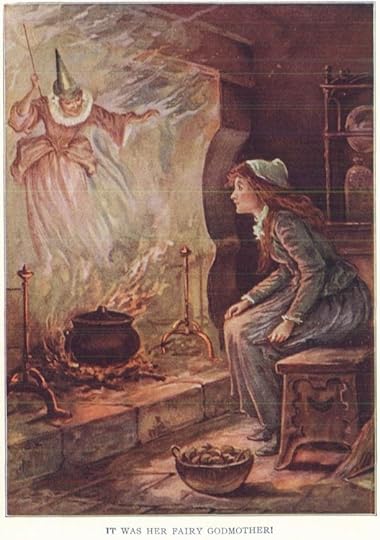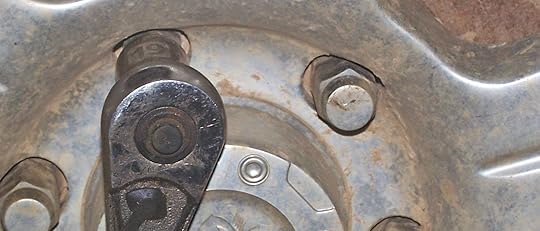If the Shoe Fits
In Cinderella, the glass slipper only fit Cinderella’s foot. As the story goes, of all the girls in all the castles in all the kingdom, the shoe fit her foot and hers alone. No matter how hard they tried, the other girls couldn’t wear the glass slipper.
 Oliver Herford, Public Domain
Oliver Herford, Public Domain
Your synopsis is the shoe, your story is the foot. Stick with me now…
So, you’re working on your first (or next) Great American Novel. You’ve written the first few chapters, and you’re dipping your toes into contests and even getting brave and submitting to agents and editors. Or, you might even be selling on proposal, a short synopsis and a chapter or two.
If you’re at this stage of the writing game, then you’ve written the dreaded synopsis. There are great articles here in Seekerville and all over the ‘net to help you determine what goes into a synopsis and what doesn’t, so I’m not going to rehash that today.

But what I am going to address is whether your synopsis reflects the story you’re writing. Sometimes we writers—intentionally or maybe unintentionally— sensationalize our synopsis to the point that it doesn't even resemble the actual chapters, similar to the practice of padding a resume.
How many times have I dumped every conceivable plot device into my synopsis because a critique partner or contest judge suggested it, and I thought it would be cool? I wonder how many times I gave the "snake oil" sales pitch in the synopsis, but the story didn't live up to the synopsis and that's why contest judges and editors said no?
Some examples to make my point…
If I write a synopsis that sounds like a very dark 90K romance that deals with drunk driving, a family feud, long-lost love, and two main characters dealing with all this traumatic back story, but if my opening chapters feel and sound like a 20K novella, there’s a disconnect somewhere.
Or, how about this…
If my synopsis describes the lives of Bonnie and Clyde, but my chapters are the light-hearted, knee-slapping antics of Lucy and Desi, I’ve got a problem.
The best example I can give of my own writing would be my debut novel, Stealing Jake. Stealing Jake started out as a light, sweet novella and went through several rewrites that kept upping the tension.
If I had sent the lighter novella version of the story in with a synopsis detailing shipping street kids across the country in crates, sweat shops, a coal mine explosion, the traumatic incidents from both the hero and the heroine’s pasts, it just wouldn't have really worked together. And I’m afraid it would have tanked in contests, as well as been rejected by industry professionals.
It’s important to make sure a contest judge, critique partner, agent or editor gets the same jolt from the chapters as they do from the synopsis. Either the tension in the chapters need to be ratcheted up, or the tension in the synopsis ratcheted down. And, you, as the author, are the only one who knows which direction you need to turn the ratchet.

So, how do you do that?
Is your manuscript in the early stages or is it completed? If it’s completed, then you’re ahead of the game. Write your synopsis to fit the story and you're good. If you’ve just started this story, determine the genre and the tone. Do you write light-hearted contemporary romance, or dark historicals, or women’s fiction with snarky leads?
Read books that are similar to what you write, then describe them in your own words, just like giving a book report. See if you can hit the tone of these books. And, as an additional exercise, maybe look at some good professional reviews of those books. Do some of them describe whether the book was light, or dark? Do you agree with the assessment?
If you have a critique partner, let them read both. If they’ve worked with you a long time, they might be able to tell you if the two pieces are simpatico.
And, lastly, trust yourself. If you got it wrong, it’s not the end of the world. Just keep tinkering with it. Eventually, you’ll get it. Over the years, I've submitted multiple proposals for historical romance novellas to Barbour Publishing. The proposals were extremely short, but I’ve been writing historical romance for a long time, and I’ve written a lot of proposals for novellas, and read my fair share.
I knew enough about the process to keep the synopsis sharp, clean, and free of secondary plots. I sold FOUR proposals to Barbour in one year because I nailed the synopsis. As expected, the novellas have a lighter tone than my full-length novels, and the one (Shanghaied by the Bride) even had a bit more of a humorous tone than is my norm, something that was clearly spelled out in the synopsis and was also clear in the title, which Barbour kept.
Bottom line, know the story you want to tell well enough to make the synopsis fit.
Otherwise, that shoe's really gonna pinch.

 Pam Hillman was born and raised on a dairy farm in Mississippiand spent her teenage years perched on the seat of a tractor raking hay. In those days, her daddy couldn’t afford two cab tractors with air conditioning and a radio, so Pam drove the Allis Chalmers 110. Even when her daddy asked her if she wanted to bale hay, she told him she didn’t mind raking. Raking hay doesn’t take much thought so Pam spent her time working on her tan and making up stories in her head. www.pamhillman.com
Pam Hillman was born and raised on a dairy farm in Mississippiand spent her teenage years perched on the seat of a tractor raking hay. In those days, her daddy couldn’t afford two cab tractors with air conditioning and a radio, so Pam drove the Allis Chalmers 110. Even when her daddy asked her if she wanted to bale hay, she told him she didn’t mind raking. Raking hay doesn’t take much thought so Pam spent her time working on her tan and making up stories in her head. www.pamhillman.com
 Oliver Herford, Public Domain
Oliver Herford, Public DomainYour synopsis is the shoe, your story is the foot. Stick with me now…
So, you’re working on your first (or next) Great American Novel. You’ve written the first few chapters, and you’re dipping your toes into contests and even getting brave and submitting to agents and editors. Or, you might even be selling on proposal, a short synopsis and a chapter or two.
If you’re at this stage of the writing game, then you’ve written the dreaded synopsis. There are great articles here in Seekerville and all over the ‘net to help you determine what goes into a synopsis and what doesn’t, so I’m not going to rehash that today.

But what I am going to address is whether your synopsis reflects the story you’re writing. Sometimes we writers—intentionally or maybe unintentionally— sensationalize our synopsis to the point that it doesn't even resemble the actual chapters, similar to the practice of padding a resume.
How many times have I dumped every conceivable plot device into my synopsis because a critique partner or contest judge suggested it, and I thought it would be cool? I wonder how many times I gave the "snake oil" sales pitch in the synopsis, but the story didn't live up to the synopsis and that's why contest judges and editors said no?
Some examples to make my point…
If I write a synopsis that sounds like a very dark 90K romance that deals with drunk driving, a family feud, long-lost love, and two main characters dealing with all this traumatic back story, but if my opening chapters feel and sound like a 20K novella, there’s a disconnect somewhere.
Or, how about this…
If my synopsis describes the lives of Bonnie and Clyde, but my chapters are the light-hearted, knee-slapping antics of Lucy and Desi, I’ve got a problem.
The best example I can give of my own writing would be my debut novel, Stealing Jake. Stealing Jake started out as a light, sweet novella and went through several rewrites that kept upping the tension.
If I had sent the lighter novella version of the story in with a synopsis detailing shipping street kids across the country in crates, sweat shops, a coal mine explosion, the traumatic incidents from both the hero and the heroine’s pasts, it just wouldn't have really worked together. And I’m afraid it would have tanked in contests, as well as been rejected by industry professionals.
It’s important to make sure a contest judge, critique partner, agent or editor gets the same jolt from the chapters as they do from the synopsis. Either the tension in the chapters need to be ratcheted up, or the tension in the synopsis ratcheted down. And, you, as the author, are the only one who knows which direction you need to turn the ratchet.

So, how do you do that?
Is your manuscript in the early stages or is it completed? If it’s completed, then you’re ahead of the game. Write your synopsis to fit the story and you're good. If you’ve just started this story, determine the genre and the tone. Do you write light-hearted contemporary romance, or dark historicals, or women’s fiction with snarky leads?
Read books that are similar to what you write, then describe them in your own words, just like giving a book report. See if you can hit the tone of these books. And, as an additional exercise, maybe look at some good professional reviews of those books. Do some of them describe whether the book was light, or dark? Do you agree with the assessment?
If you have a critique partner, let them read both. If they’ve worked with you a long time, they might be able to tell you if the two pieces are simpatico.
And, lastly, trust yourself. If you got it wrong, it’s not the end of the world. Just keep tinkering with it. Eventually, you’ll get it. Over the years, I've submitted multiple proposals for historical romance novellas to Barbour Publishing. The proposals were extremely short, but I’ve been writing historical romance for a long time, and I’ve written a lot of proposals for novellas, and read my fair share.
I knew enough about the process to keep the synopsis sharp, clean, and free of secondary plots. I sold FOUR proposals to Barbour in one year because I nailed the synopsis. As expected, the novellas have a lighter tone than my full-length novels, and the one (Shanghaied by the Bride) even had a bit more of a humorous tone than is my norm, something that was clearly spelled out in the synopsis and was also clear in the title, which Barbour kept.
Bottom line, know the story you want to tell well enough to make the synopsis fit.
Otherwise, that shoe's really gonna pinch.

 Pam Hillman was born and raised on a dairy farm in Mississippiand spent her teenage years perched on the seat of a tractor raking hay. In those days, her daddy couldn’t afford two cab tractors with air conditioning and a radio, so Pam drove the Allis Chalmers 110. Even when her daddy asked her if she wanted to bale hay, she told him she didn’t mind raking. Raking hay doesn’t take much thought so Pam spent her time working on her tan and making up stories in her head. www.pamhillman.com
Pam Hillman was born and raised on a dairy farm in Mississippiand spent her teenage years perched on the seat of a tractor raking hay. In those days, her daddy couldn’t afford two cab tractors with air conditioning and a radio, so Pam drove the Allis Chalmers 110. Even when her daddy asked her if she wanted to bale hay, she told him she didn’t mind raking. Raking hay doesn’t take much thought so Pam spent her time working on her tan and making up stories in her head. www.pamhillman.com
Published on March 24, 2022 22:00
No comments have been added yet.



